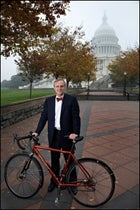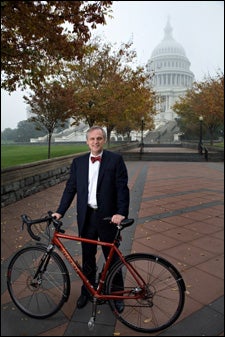Tucked deep down behind the new leases for off-shore drilling in the , a broad energy bill that the House passed , were the tiny remains of something called the Bicycle Commuter Act. , of Oregon’s Third District, originally sponsored the bill last session in hopes of bringing bicycles into the commuting mainstream by offering reimbursements and subsidies to the calorie-powered. We caught up with the Congressman, who regularly bikes to his DC offices, to talk about bike safety, infrastructure, and how the might spread.
Congressman Blumenauer
 The Congressman standing by his bike in Washington D.C.
The Congressman standing by his bike in Washington D.C.What’s the basic idea of the Bike Commuter Act?
The concept is to provide equity for people who burn calories instead of fossil fuel. Currently, we provide hundreds of dollars of tax-free parking benefits, up to a couple thousand dollars a year for people who drive their cars to work, and to employers who might want to help them. But if you burn calories instead of fossil fuels, there’s no tax benefit. That seems unfair, inequitable, and, frankly, when we are facing twin challenges of energy costs and supply, coupled with global warming and an obesity epidemic, it doesn’t seem like very good policy.
The original Bike Commuter Act, after being stymied in the Senate earlier this year, passed the House again as a rider on the Comprehensive American Energy Security and Consumer Protection Act, which also opens up off-shore areas to drilling for oil and natural gas. Isn’t that ironic?
It’s part of a broader picture. Our commitment is to work to make sure that there is no energy legislation that does not provide equity for bicycle commuters. With policies like that, we continue to try to educate members of congress and use whatever legislative vehicles that are available.
Are you trying to get more people commuting by bicycle, or are you just trying to reward those who already do?
It’s both. It’s fun and less expensive to commute by bike, but it isn’t free. People spend money. My commuting bicycles are not expensive bikes, but it costs money to buy and maintain them, and there are other people who, for example if you’re commuting in my home town of , you need to be prepared for rain. And some people don’t have shower facilities at work, so they will have a local health club facility they might have to seek a membership in. There are real costs associated that are much less than commuting by car, but that people ought to be able to have help with. It is also important to send signals that this not just acceptable, but a good idea. By giving people a little financial incentive, that’s another step in the right direction.
But there’s also the safety of the cyclists on the roads, especially in places where there aren’t the bike boulevards there are in Portland. Aren’t you sending people out to commute in a way that could be considered unsafe?
There are major challenges across the country for people who bike and walk. We under-invest in the safety of the cyclists and pedestrians. But we’re working to change that. For instance, in the last transportation bill we had about two-thirds of a billion dollars for safe routes to school. We’ve introduced legislation to expand that for example to high school students. There is more work that needs to be done. We found in Portland, when you provide bike lanes and bike boulevards and bike paths, signage, when you help provide a system, it increases participation and safety, makes it easier. That’s part of a national movement. We had legislation that passed earlier in the year, the National Bike Bill, that deals with the complete picture of what cyclists need.
[The key line from H. Res. 305: Congress “recognizes that increased and safe bicycle use for transportation and recreation is in the national interest.”]
Do you bike to work yourself?
I made a decision when I came to Washington D.C. a dozen years ago that I was going to bring a bicycle instead of a car. Every day for a dozen years, including this morning, I cycled to work. I went to my meetings after work last night on a bike. About once a week in Portland, because of my schedule, I’m able to use a bike instead of a car.
Portland is an exceptional model in bike use. But how are you going to make that model spread? How are you going to convince people that it’s not just Portland doing it their way out there?
What we are finding is that bicycle usage is going up. I mentioned these challenges of global warming, rising energy prices, and obesity, that neatly point to increased cycling as a solution. Part of it is helping with the infrastructure. You’re right to point it out. And it’s something we’re working very hard on in Congress and in the local communities. Just yesterday we had Mayor Bloomberg join us before our Ways and Means Committee. He’s been very aggressive in improving . Mayor Daley in is quite a cyclist himself. We’re watching the growth of a national movement. If it works in Portland, it can work anywhere.
Now we don’t have the best weather. It’s no secret that it rains a lot. We have some challenging topography, but we have about six percent of the people who use the bicycle as their major commute option in Portland, and some of the inner city neighborhoods’ percentages are much higher. My wife is a corporate executive who frequently bikes to work.
Any specific influences or models from abroad that you’ve been working with in developing this legislation?
For the last 15 years we’ve been in consultation with initiatives that have taken place in other countries. I’ve been impressed with Amsterdam, specifically, and the Netherlands in general. I’ve cycled around the Netherlands. I’ve taken cycling vacations, one of which began and ended in the Netherlands. Looking at Copenhagen, with what they’ve done with cycling and recovering public spaces, closing streets to automobiles, there’s some great European examples. And there are also some negative examples. One that kind of breaks your heart is taking place in China, where they’re actually closing areas to bicycles, because they think it looks– it’s not classy, you know, it’s not modern. It’s not all in the right direction. But in the main, we can learn from each other, be inspired.
But I’m very pleased with what’s happened with some of the university towns in the United States. comes to mind, but we’ve done a pretty good job in and Eugene, Oregon. And then the initiatives with bike sharing. I first encountered this a dozen years ago in 1995 in Copenhagen, but we’ve seen what happened with the now with over 20,000 bikes.
John Kerry was —— a road biker, and George W. Bush is famously a mountain biker. Where do you see bikes fitting in to November?
We worked with leaders in the cycling community, for a great political event for . He’s a leader . He’s very supportive of cycling. There’s some great pictures earlier in the year with the Senator and his wife Michelle and their two daughters in Chicago. No one would confuse him in those pictures with Kerry and Bush with their high-end equipment, hitting it hard. In terms of the picture I’d like to have for America, I’m actually more interested in Senator Obama and his young family out cycling on a weekend, showing how approachable and fun, and you don’t need Lycra and ten-thousand-dollar bikes. The family can be out there and enjoy the experience, each other, get exercise, and seek community.
If this $20-a-month fringe benefit passes the Senate, what’s the next issue to tackle with cycling for you?
We will be looking at comprehensive efforts to enhance the cycling experience. What you mentioned about bike facilities — here in Washington, D.C., for instance we’ve been working on launching a . A bike central at Union Station. There are opportunities around the country to integrate the bicycle into the urban fabric. The second piece will be expansion of the safe routes to schools. Having a national network of bike trails and paths, I think will be high on the agenda.
Do you see bicycle legislation continuing to be part of an energy policy?
Absolutely. We haven’t begun to scratch the surface for ways that cycling can help the environmental and physical health of our communities.
So does this mean that you’re anti-car?
Absolutely not. I have a car and I use it. It’s a hybrid, and I try to use it intelligently. It’s got a bike rack. This is not anything to do with being opposed to cars or to force anybody to do anything. [Right now] people have no choice but to burn a gallon of gas when they want a gallon of milk.

